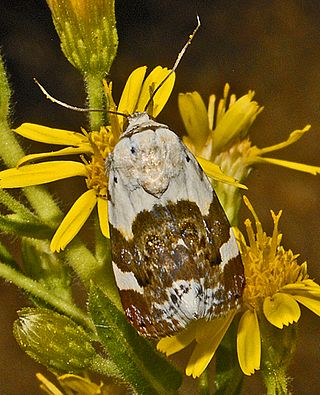
Melanargia galathea, the marbled white, is a medium-sized butterfly in the family Nymphalidae. Despite its common name and appearance, this butterfly is one of the "browns", of the subfamily Satyrinae.

The mint moth is a small moth from the family Crambidae, also known by the common name Small Purple and Gold.

The Thyrididae comprise the family of picture-winged leaf moths. They are the only family in the superfamily Thyridoidea, which sometimes has been included in the Pyraloidea, but this isn't supported by cladistic analysis.

Scopula imitaria, the small blood-vein, is a moth of the family Geometridae. It was first described by Jacob Hübner in 1799 and it is found throughout Europe and in North Africa.

Scopula marginepunctata, the mullein wave, is a moth of the family Geometridae. It was described by Johann August Ephraim Goeze in 1781. It is found throughout Europe.

Idaea fuscovenosa, the dwarf cream wave, is a moth of the family Geometridae. It is found in the Palearctic,

Palpita vitrealis, common name jasmine moth or white pearl, is a species of moth of the family Crambidae.

Cilix glaucata, the Chinese character, is a moth of the family Drepanidae. It was first described by the Italian physician and naturalist, Giovanni Antonio Scopoli in his 1763 Entomologia Carniolica. It is found in Europe, Asia Minor and North Africa.

Thalera fimbrialis, the Sussex emerald, is a species of moth of the family Geometridae. It is found in Europe and across the Palearctic up to the area surrounding the Amur River.

Cymbalophora pudica, the discrete chaperon, is a moth of the family Erebidae. The species was first described by Eugenius Johann Christoph Esper in 1784.

Zygaena purpuralis, the transparent burnet, is a moth of the family Zygaenidae.

Pammene aurana is a moth of the family Tortricidae.

Epinotia nisella is a moth of the family Tortricidae which is found in the Palearctic, Europe and North America. It was first described be Carl Alexander Clerck in 1759.

Acontia lucida, the pale shoulder, is a moth of the family Noctuidae. The species was first described by Johann Siegfried Hufnagel in 1766.

Eupithecia pygmaeata, the marsh pug, is a moth of the family Geometridae. It is known from most of Europe, western and southern Siberia, the Russian Far East, northern Mongolia and North America .The species primarily colonizes floodplain and disused forests, bogs, river banks and marshy meadows. E. pygmaeata reaches up to 1800 meters in South Tyrol.

Zygaena sarpedon is a moth of the Zygaenidae family. It is found in France, Italy and on the Iberian Peninsula.

Zygaena hilaris is a species of moth in the family Zygaenidae.

Falseuncaria ruficiliana, the red-fringed conch, is a species of moth of the family Tortricidae. It is found in China (Xinjiang) and most of Europe. The habitat consists of limestone, heathland and moorland.

Thyris is a genus of moths of the family Thyrididae.

Thyris maculata, the spotted thyris, is a species of window-winged moth in the family Thyrididae.






















